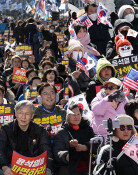Korea’s birth rates make the first turnaround in nine years
Korea’s birth rates make the first turnaround in nine years
Posted January. 31, 2025 07:28,
Updated January. 31, 2025 07:28
A man in his 30s, who works at a small company, got married about three years ago. “I won’t have children,” he said before his wedding. “I do not want to spend all his money and time raising children. Instead, he dreamed of always traveling around with his wife.” Contrary to his plans, he became a father around a month ago. Asked what changed his mind, he only smiled. When asked again if the expansion of government support, including parental benefits, affected his decision, he replied, “Giving money alone does not encourage me to become a parent. I have to admit that all the perks for my baby alleviate some of the financial burden.”
Last year, South Korea surely showed a turnaround in birth rates for the first time in nine years. Vice Chairman Joo Hyung-hwan of the Low Birth Rate and Aging Society Committee recently projected last year’s fertility rate to be 0.75 children. This metric, the average number of children a woman is expected to have in her lifetime, has constantly declined since 2015. The fertility rate, which once stood at 1.24, dropped to 0.72 as of 2023. It is welcome news that it has been starting to bounce back. If last year’s total fertility rate turns out to be 0.75, it would mean a faster upward trend, compared to the projections from 2022 to 2072 made by Statistics Korea that birthrates would go down to 0.65 (median projection) this year and turn around starting from 2026.
Nevertheless, a total fertility rate of 0.7 is still seriously low, which requires us to keep working against a potential demographic crisis. To maintain the current population, the country needs to keep a fertility rate at 2.1 at the minimum. If the figure persists at 0.7 for two generations, the number of potential parents who can bear and rear children will decrease to less than half the current levels. To be specific, 1,000 people in today's parent generation have 700 children, and those 700 will only give birth to 490 kids of their own. Although the overall population decline rate will change depending on mortality rates, immigration, etc., we are nowhere near ensuring the country’s long-term sustainability.
It is also uncertain whether last year’s recovery can continue. Some say that it may be an illusionary uptick due to a temporary increase in the population that can become parents as they enter the prime age for marriage. The country had seen more than 800,000 newborns a year until 1982, but experienced a decline to approximately 600,000 in 1990. Afterward, it witnessed a brief comeback to the 700,000 range from 1991 to 1995. Those born during this period are now 30 to 34 years old. As for today’s 24-year-olds, born in 2001, 560,000 births were recorded for that year. Following this, yearly births remained in the 400,000 range for a 15-year period.
Local municipalities across the country are set to continue their childbirth incentives this year as well. Goyang City in Gyeonggi Province, which gives a subsidy of one million won to the first child, has allocated 7.8 billion won for this year’s budget. Likewise, Busanjin-gu in Busan has decided to raise the childbirth congratulatory payments for second and third children by 300,000 won and 400,000 won, respectively. However, opponents say that cash-based support will only make a short-lived difference. As per an analysis by the Korea Institute of Local Finance on childbirth policies from 2009 to 2021, providing childbirth incentives of one million won only resulted in a 0.03 increase in the total fertility rate. Ironically, even the government agency, which was set up to oversee low birthrate policies, has reportedly voiced complaints about “work-life balance.” To keep the rebound trend going, it will be more important to closely examine our work culture.







